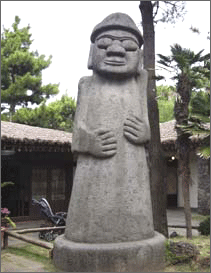GNSS waves at Jeju
Dec 2006 | Comments Off on GNSS waves at Jeju
|
|
| The 12th World Congress of the International Association of Institutes of Navigation took place on the island of Chesu, or more commonly Jeju, off the southwest coast of Korea, between the dates of 18 and 20 October 2006. The IAIN Congress was hosted and organised by the Korean Institute of Navigation and Port Research (KINPR) in parallel with the Korean GNSS Technology Council’s 2006 International Symposium. English was the conference language throughout. Some 252 papers had been offered and 169 selected for presentation or as posters. There were 243 delegates from 30 countries and 20 exhibitors.The IAIN Officers met before the conference, received reports from office-holders, representatives to other international bodies, appointed Elisabeth Klaffenboeck (Austrian ION) as the new representative to ICG and made the final preparations for the IAIN General Assembly that started later that day. Draft minutes of both of these meetings have been circulated widely and will be posted on the IAIN website. The major points arising from the General Assembly included an increase in annual subscriptions, homologation of the Harrison Award made in 2005 to Dr. Kotaite (then President of ICAO) and the Necho Award in 2006 to Captain Norman Cockcroft (outgoing IAIN representative to IMO), approval of the selection of Stockholm as the venue for IAIN Congress 2009 organised by the Nordic Navigation Forum and the election of Officers for 2006-09. Among the latter were Dick Smith as President and Norman Bonnor as Secretary General.
The combined meeting ran for the next 3 days with, apart from plenary, 5 parallel sessions plus a tutorial domestic stream. The keynote speakers were Vidal Ashkanzi

|
who described the ‘Evolving GNSS Panorama’ in a thorough, thoughtful and thematic style. John Dow from the European Space Agency followed with an excellent coverage of the practical support that the International GNSS Service (IGS) provides for new developments in satellite-based navigation systems. There then followed special talks by Ruth Neilan (GPS policy and status) Guenter Hein (Galileo: the complement or competition to GPS?) and Susumu Yoshitomi
|
|
|
(QZSS status). Sadly the Liqing Shao (Chinese activities on GNSS) was unable to make the conference. In the parallel sessions that followed it was impossible for any one rapporteur to cover everything. To give a snap shot I chaired the general navigation maritime applications session and found it a worthwhile mixture of academic research (collision avoidance, interaction between ships) and practical application (ships’ speed when docking, pilotage). Other presentations that caught my attention included the effects of geomagnetic storms, radio occultation, GPS policy in India and the impact of sea level rises on port facilities. No doubt other chairmen had similar experiences. Each speaker in the sessions was evaluated on his/her performance. The final plenary received a summary of the Congress from Jinsoo Park (KINPR), presentation of the IAIN Awards [including the Sadek best presentation won by J-B Park of TU Braunschweig for his paper on Integrated Navigation and Sense & Avoid Systems for Micro-Aerial Vehicles], details of the 2009 Congress, followed by closing remarks from Bengt Stahl (outgoing IAIN President) and Doo Chan Chang (KINPR President).
|
| Dick Smith, President, International Association
of Institutes of Navigation |
|
|













 (No Ratings Yet)
(No Ratings Yet)




